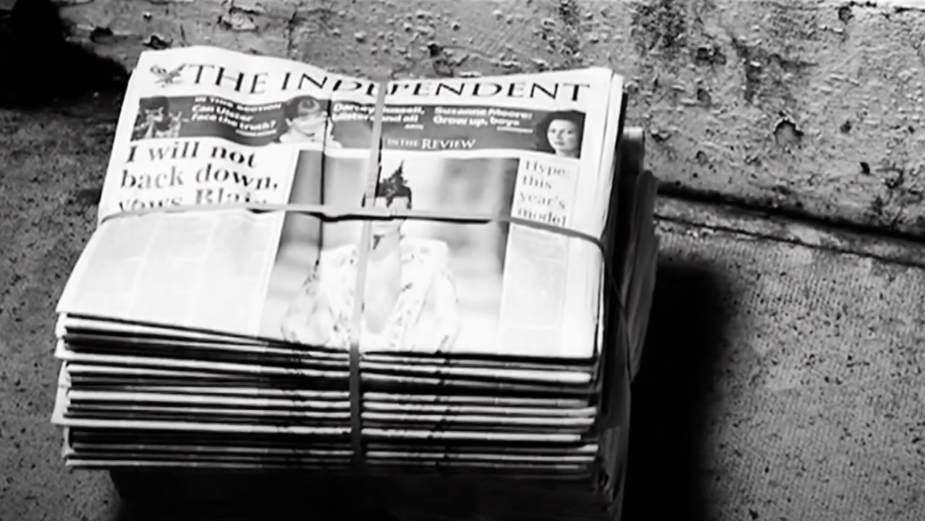Dom Megna, ECD for Melbourne based independent agency Spinach Advertising talks being a copywriter at age 12.
Dom Megna is an old ad nerd and executive creative director of Melbourne indie Spinach Advertising. After stints at Grey Worldwide and BADJAR, Dom spent 15 years at CHE Proximity, the last 10 as creative director. After completing an EMBA at Melbourne Business School, in 2021 Dom departed for the head of brand & creative role at funeral startup, Bare Cremation.
In a little over 12 months Dom built the Bare brand from the ground up, devised and executed Bare’s narrative and brand and social strategy, created an award-winning outdoor campaign, launched a new referral program, delivered an industry standard digital platform and wrote and produced and directed our first TV campaign.
Person: What kind of creative person are you?
I landed on copywriting when I was 12 or 13. Art and ideas and interesting things fascinates me. But advertising in particular was the most accessible creative field. I would walk past a TV as a kid and always stop for an ad. Dissect it. Think about why it was the way it was. The intersection between art, influence and commerce is an endlessly fascinating topic.
I’m innately curious, but I’m not innately creative. Most people I know who are innately creative are doing it for themselves rather than brands. I need to will myself to extract every inch of creativity I possess. I can’t adhere to a routine because I need to draw on every person, influence, lived experience, desire, ambition, memory and any other springboard I can. That just happens when it happens.
The things I enjoy are nothing like the work I do. I write a blog reviewing pubs, I have particular tastes in music, design, cars… Anything interesting that’s a bit weird and beautiful is something I want to spend time with.

Product: How do you judge the creativity of a piece of work?
I judge work on whether it stops me. While it’s primarily about the idea it often depends on the mindset and place I’m in at the time. A billboard that gives you pause on a freeway is very different to a 15sec BVOD spot you’re forced to sit through during an emotional show while feeling vulnerable, which is different again from when a brand leaps out of the bushes at you for a laugh. As a result, I think work that won’t get any nods during award-season can still be excellent because it cleverly understands when and how it will be consumed.
That all said, things like Give a Flybuys, the Tide ad or the old ‘Litany’ spot from The Independent in the UK are holy grails – perfect on many levels. They knew their objectives and audiences, they knew where they appeared and what they meant to people at the time.
The criteria I use to judge my own work has shifted over the years. I’ve moved from just wanting to do cool shit to recognising the potential impact of each project. An example is when I was heading up creative at a funeral startup – rewriting their various on-hold messages. I would have scoffed at this job previously and whipped through it. But on-hold messages for a funeral company are arguably their most important tool to communicate with potential customers. They’ve called, likely during one of the worst moments of their life, and now they’re being made to hold, in order to talk to someone they don’t know or trust. These on-hold messages are the first impression. You can’t get more important. They needed to be perfect.
While the work in adland now is good as it’s ever been, there’s too much focus on the coolness of the work rather than the impact it’s making. By that I mean proper real-world impact, not ad industry impact. It would be amazing to see more award shows adopt stronger impact and effectiveness criteria as part of their judging.

Process: Tell us about how you like to make creative work.
I approach briefs from all over the place. Pulling insights and random shit out of thin air, half scribbled post-its, emailing myself, shower ideas I need to repeat in my head until I have access to a pen. I don’t use any tools to help ideate but I always say the maybe ideas out loud. To someone. Anyone. As soon as the words spill out my mouth I know if a maybe idea is a shit one.
Another litmus test when progressing ideas is Damon Stapleton’s first immutable law of advertising – nobody cares about advertising. That’s always at the front of my mind. I’m really big on being involved in making. Endless hours in the edit suite is great fun. I’m also directing more and more which is satisfying and quells the inner control freak.
Creatives often put so much effort into the work, then you put it out in the world and you want, almost demand, everyone take notice. When that happens it’s great. But if they don’t, or appear to not to notice, it’s demoralising. Feels like nobody cares about your ads when you’re utterly convinced they should.
But things happen. Some weeks, or months later you might see an uptick in awareness, sentiment or sales, hear a story from a franchisee or customer, whatever, and you realise that that thing you made might not have created noise when it launched, but it made an impact.

Press: What external factors have shaped you and what can make or break a creative project?
After 20 years in agencies, and the one creative partner (hi Rogan), going client-side meant I suddenly was left to no marketing structures or processes and very little support. I wore all the hats which has given me a better appreciation of everyone in the process. (I’ll never get mad at a producer again.) It also reminded me, in the most utterly direct way, of the accountability of what I do. Getting to know clients and dig into their minds and their business issues is something I’ve always enjoyed. At a startup it’s the majority of what you do. I’m so thankful for that experience and a lot better because of it.
Overall, my creative dept is always my biggest influence. I’m lucky as it’s always been a lovely nest of individuals who love and support one another. If you’re a client looking to work with an agency, get a read on the creative dept. It’s the kitchen, you want the best turning out the work, but also ones who bring each other up.
The best way for an agency to facilitate a healthy creative culture starts by letting creatives do their thing. Not meddling with organic processes and relationships allows personalities and styles to shine. Many creatives are quite introverted so the culture can ebb and flow but when it’s flying it’s so worth it. It’s also created by suits and producers and money people starting with yes and working back from there. We’re confronted with a hard no so early and often that a culture of yes makes you feel like anything is possible. Sounds like some kind of LinkedIn cereal box platitude, but when you plant that seed it’s a beautiful thing.





